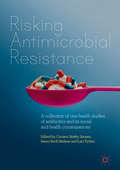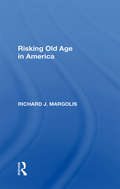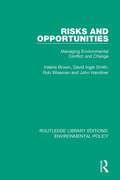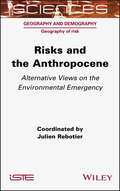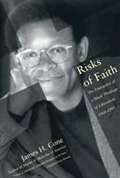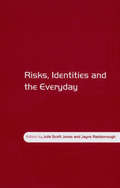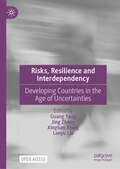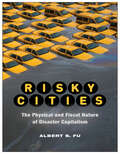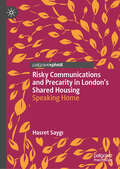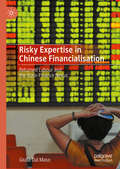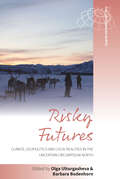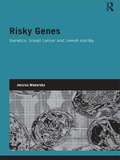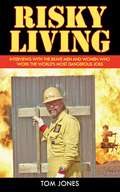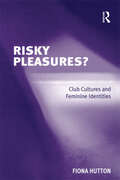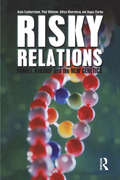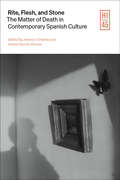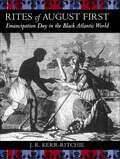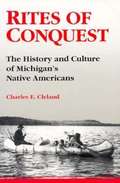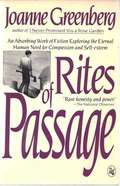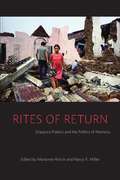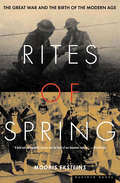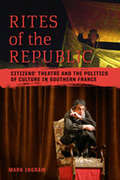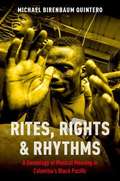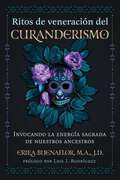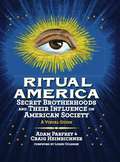- Table View
- List View
Risking Antimicrobial Resistance: A collection of one-health studies of antibiotics and its social and health consequences
by Carsten Strøby Jensen Søren Beck Nielsen Lars FynboAntimicrobial resistance (AMR) is predicted to be one of the greatest threats to public health in the twenty-first century. In this context, understanding the reasons why perceptions of antibiotic risk differ between different groups is crucial when it comes to tackling antibiotic misuse. This innovative volume gathers together chapters written by sociologists, psychologists and linguists with the common aim of examining the social factors that affect use of antibiotics among humans and animals. A unique focus on Denmark – one of the world’s most progressive countries when it comes to antibiotic regulation – as well as Europe more broadly, makes this book a valuable resource for regulatory deliberations on future antibiotic policy to effectively combat AMR.
Risking Old Age In America
by Richard J. MargolisOriginally published in 1990. Research into the provison made for the 30 million Americans, aged sixty-five and up, whom society calls "old."
Risks and Opportunities: Managing Environmental Conflict and Change (Routledge Library Editions: Environmental Policy #5)
by Valerie Brown John Handmer David Ingle Smith Rob WisemanFirst published in 1995. Managing today’s rapidly changing environment inevitably involves managing conflicts between the demands of development and conservation; the needs of the present and of the future; and between different community interests, professional positions and political priorities. Risks and Opportunities provides both a guide to managing environmental change, and a training manual to pave the way to successful conflict resolution. It explores the full range of potential conflicts and looks at various methods for their resolution. It covers the who, what, why and when of managing change, and emphasizes the need to develop an active and strategic approach which indemnifies the interests and abilities of all the stakeholders. The book’s detailed case studies provide in-depth material on the conflicting uses of urban, agricultural and natural environments, and the self-teaching guide and exercises will enable individual readers and organizations to acquire the necessary practical and team-building skills.
Risks and the Anthropocene: Alternative Views on the Environmental Emergency
by Julien RebotierThe Anthropocene refers to all societies’ current era of environmental challenges. For the social sciences, the Anthropocene represents a historical “moment” with huge potential: it offers people new ways of considering the human condition, as well as how they interact with the rest of the living world and with the planet on all levels. At the turn of the 21st century, the idea of the Anthropocene burst onto the older, diverse and varied scene of risk studies.This “new geological era”, which is entirely created by humanity, went on to revive our understanding of environmental issues, as well as the analysis of the social and political problems that constitute risk situations.Drawing together contributions from specialists in social sciences concerning risks and the environment, Risks and the Anthropocene explores the advantages that the idea of the Anthropocene can offer in understanding risks and their management, as well as the limitations it presents.
Risks of Faith: The Emergence of a Black Theology of Liberation, 1968-1998
by James H. ConeThis book offers for the first time the best of noted theologian James H. Cone's essays, including several new pieces. Representing the breadth of his life's work, this collection opens with the birth of black theology, explores its relationship to issues of violence, the developing world, and the theological touchstone embodied in African-American spirituals. Also included here is Cone's seminal work on the theology of Martin Luther King, Jr., and the philosophy of Malcolm X, and a compelling examination of their contribution to the roots of black theology. Far-reaching and provocative, this book is a must-read for anyone interesting in religion and its political and social impact on our time.
Risks, Identities and the Everyday
by Jayne Raisborough Julie Scott JonesRisks, Identities and the Everyday focuses on the individual and the lived experience of everyday risks - a departure from the focus on risk from a macro level. The contributors look at risk and how perceptions of risk, risk taking, and risk assessment increasingly dominate our everyday lives and explore it in a variety of settings not previously associated with risk theory, including: plastic surgery, teenage sub-cultures, ageing and independent travel. The volume moves risk away from abstract theorising about what people may or may not fear about risks, to focus on how it actually materialises and operates in everyday 'real' social interactions and contexts. It also interrogates the rational self at the heart of macro social theories by thinking through the construction of risk choices and the socio-cultural dynamics that 'present' some risks as acceptable, appropriate and necessary.
Risks, Resilience and Interdependency: Developing Countries in the Age of Uncertainties
by Jing Zhang Guang Yang Lanyu Liu Xinghan XiongThis open access book is a collection of selected papers from the 3rd Tsinghua Area Studies forum by the Institute for International and Area Studies (IIAS) at Tsinghua University in Beijing, theming at &“Developing Countries in the Age of Uncertainties: Risk, Resilience and Interdependency&”. From the perspective of area studies, the risks faced by more fragile developing countries in an environment of uncertainty and the resilience and interdependency exhibited in the face of risks were discussed. The discussion was a brave attempt by the IIAS to inject more certainty into the uncertain world. A total of 131 papers by scholars from various countries were presented in this forum. After the forum, the editorial group of the IIAS Forum Proceedings selected ten outstanding papers and compiled them under the title &“Risk, Resilience and Interdependency: Developing Countries in the Age of Uncertainty.&”
Risky Cities: The Physical and Fiscal Nature of Disaster Capitalism (Nature, Society, and Culture)
by Albert S. FuOver half the world’s population lives in urban regions, and increasingly disasters are of great concern to city dwellers, policymakers, and builders. However, disaster risk is also of great interest to corporations, financiers, and investors. Risky Cities is a critical examination of global urban development, capitalism, and its relationship with environmental hazards. It is about how cities live and profit from the threat of sinkholes, garbage, and fire. Risky Cities is not simply about post-catastrophe profiteering. This book focuses on the way in which disaster capitalism has figured out ways to commodify environmental bads and manage risks. Notably, capitalist city-building results in the physical transformation of nature. This necessitates risk management strategies –such as insurance, environmental assessments, and technocratic mitigation plans. As such capitalists redistribute risk relying on short-term fixes to disaster risk rather than address long-term vulnerabilities.
Risky Communications and Precarity in London's Shared Housing: Speaking Home
by Hasret SaygıThis book examines the experiences of single professionals living in shared housing in London, focusing on how language, communication, and social inequalities shape these living arrangements. It frames shared housing not only as an economic condition but also as a communicative, social, and identity-laden experience. Drawing on the discourse analysis of interviews conducted with London&’s millennials sharing a house with strangers, the book introduces a language socialisation framework to illustrate how they learn to become competent housemates. It explores how individuals internalise unspoken norms, manage routines, and negotiate relationships within multilingual, multicultural households. The book also highlights what it means to be single and living in London today, particularly in the context of housing. It examines how house sharers navigate spatial and social boundaries and experience precarity, especially through the lenses of migration, ethnicity, and linguistic background. This book will appeal to scholars in sociolinguistics, anthropology, urban studies, human geography, and architecture.
Risky Expertise in Chinese Financialisation: Returned Labour and the State-Finance Nexus
by Giulia Dal MasoThis book focuses on the subjectivities of stock market investors to explore tensions within the Chinese state’s engagement in contemporary financial capitalism. It adopts a genealogical method to investigate how the production of foreign-trained financial experts (haigui) and informal experts (sanhu) points to paradoxes in China’s efforts to cultivate financial expertise. Chinese financialisation relates to the state’s project of financialising human capital in reaction to a contractualised labour market and the vanishing welfare state. Through ethnographic inquiry, Dal Maso shows the Chinese stock markets are crucial to the new redistributive regime where wage labour risks losing its primacy. Here, one can observe how the relationship between money and wages in China is being reworked and witness the development of a new economic order in which the state’s legitimacy becomes increasingly dependent on its capacity to jiushi–to rescue the market in times of crisis.
Risky Futures: Climate, Geopolitics and Local Realities in the Uncertain Circumpolar North (Studies in the Circumpolar North #6)
by Olga Ulturgasheva Barbara BodenhornThe volume examines complex intersections of environmental conditions, geopolitical tensions and local innovative reactions characterising ‘the Arctic’ in the early twenty-first century. What happens in the region (such as permafrost thaw or methane release) not only sweeps rapidly through local ecosystems but also has profound global implications. Bringing together a unique combination of authors who are local practitioners, indigenous scholars and international researchers, the book provides nuanced views of the social consequences of climate change and environmental risks across human and non-human realms.
Risky Genes: Genetics, Breast Cancer and Jewish Identity (Genetics and Society)
by Jessica MozerskyAshkenazi Jews have the highest known population risk of carrying specific mutations in the high-risk breast cancer genes, BRCA1 and BRCA2. So what does it mean to be told you have an increased risk of genetic breast cancer because you are of Ashkenazi Jewish origin? In a time of ever-increasing knowledge about variations in genetic disease risk among different populations, there is a pressing need for research regarding the implications of such information for members of high-risk populations. Risky Genes provides first-hand intimate descriptions of women’s experiences of being Jewish and of being at increased risk of genetic breast cancer. It explores the impact this knowledge has on their identity and understanding of belonging to a collective. Using qualitative data from high-risk Ashkenazi women in the UK, this book elucidates the importance of biological discourses in forging Jewish self-identity and reveals the complex ways in which biological and social understandings of Jewish belonging intersect. In Risky Genes, Jessica Mozersky reflects upon and offers new insight into the ongoing debates regarding the implications of genetic research for populations, and of new genetic knowledge for individual and collective identity. The book will be of interest to students and scholars of sociology, anthropology, Jewish studies, medical genetics, medical ethics, religious studies, and race and ethnic studies.
Risky Living: Interviews with the Brave Men and Women who Work the World's Most Dangerous Jobs
by Tom JonesRisky Living is a fascinating collection of candid and intimate conversations with forty-five men and women who describe, in gripping detail, how physical risk is a familiar companion in their working lives, and how they deal with it. This is the first work of oral history to focus solely on people who work dangerous jobs. In the great tradition of books revealing the real lives of working men and women pioneered by Studs Terkel, Risky Living takes readers: Inside Antron Brown's car as he launches his top fuel drag racer from zero to over 300 miles per hour Alongside world champion bull rider Justin McBride as he attempts to stay atop a 1,600-pound beast Next to storm chasing videographer Jeff Gammons as he painfully remembers the screams of Hurricane Katrina drowning victims Right behind Cameron Begbie as he recalls fighting hand-to-hand against insurgents in Iraq Inside the huddle with two-time Pro Bowl NFL player Kassim Osgood In the back of the jeep with National Geographic wildlife photographer Andy Casagrande Down the shaft with coal miner Jeff Shiner Into the swamp with alligator trapper Tredale Boudreaux 100 stories up with high-rise window washer Walter Diaz Risky Living reveals who these daring people are, what they endure for a paycheck, and how they feel about their jobs. They speak for themselves, in their words, and what they have to say reveals much about who they are, what they do, and why they do it.
Risky Pleasures?: Club Cultures and Feminine Identities
by Fiona HuttonIn this book Fiona Hutton provides a fascinating insight into women's experiences of clubbing. Based on a rich ethnographic account of the Manchester club scene, Risky Pleasures? is set within the context of the theoretical literature on youth subcultures, female friendship, consumption, risk and the city. The work highlights both the producers of club scenes - promoters, DJs, dealers - and the consumers - women negotiating pleasure and risk in club spaces and in the city at night. It explores the range of club spaces, developing a typology of 'mainstream' and 'underground' clubs, and considers how different types of participants are attracted to different 'scenes'. It examines women's recreational drug-use within a club context and discusses issues of sexuality, tolerance and the importance of 'attitude' in terms of women's feelings of safety. Revealing the important role of different spaces and different atmospheres in how women participate in club scenes, Fiona Hutton argues that drug taking and sexual pleasure are always contextualized within the environments created in different spaces, and that the risk and danger negotiated by women clubbers are counterbalanced by fun and pleasure - and ultimately empowerment.
Risky Relations: Family, Kinship and the New Genetics
by Paul Atkinson Aditya Bharadwaj Angus Clarke Katie FeatherstoneIncreasingly more conditions are now being identified as having a genetic component, and controversial new genetic technologies potentially have major consequences for social relations and self-identity. How do family members respond to the information that they have a genetically transmitted disease or condition? How do they communicate (or not communicate) about their shared heritage? How do they decide who to tell and who not to tell within their family? Richly illustrated with the real experiences of individuals and families, Risky Relations is essential reading for anthropologists and sociologists of health and medicine, specialists in family and kinship, and health professionals concerned with the treatment and counselling of clients with genetic conditions. The lived impact of genetic technology on understanding within families with genetic conditions has never been systematically explored. This book fills a major gap by placing ethical, medical and social debates surrounding this charged issue firmly in context.
Rite, Flesh, and Stone: The Matter of Death in Contemporary Spanish Culture (Hispanic Issues)
by Elizabeth Scarlett William Viestenz Layla Renshaw N. Michelle Murray Eugenia Afinoguénova Pedro Aguilera-Mellado Ana Fernández-Cebrián Patty Keller Ángel Loureiro Cristina Moreiras-Menor Annabel Martín Jordi Moreras Sol TarrésForensic science provides information and data behind the circumstances of a particular death, but it is culture that provides death with meaning. With this in mind, Rite, Flesh, and Stone proposes cultural matters of death as its structuring principle, operating as frames of the expression of mortality within a distinct set of coordinates. The chapters offer original approaches to how human remains are handled in the embodied rituals and social performances of contemporary funeral rites of all kinds; furthermore, they explore how dying flesh and corpses are processed by means of biopolitical technologies and the ethics of (self-)care, and how the vibrant and breathing materiality of the living is transformed into stone and analogous kinds of tangible, empirical presence that engender new cartographies of memory. Each coming from a specific disciplinary perspective, authors in this volume problematize conventional ideas about the place of death in contemporary Western societies and cultures using Spain as a case study. Materials analyzed here—ranging from cinematic and literary fictions, to historical archives and anthropological and ethnographic sources—make explicit a dynamic scenario where actors embody a variety of positions toward death and dying, the political production of mortality, and the commemoration of the dead. Ultimately, the goal of this volume is to chart the complex network in which the disenchantment of death and its reenchantment coexist, and biopolitical control over secularized bodies overlaps with new avatars of the religious and non-theistic desires for memorialization and transcendence.
Rites of August First: Emancipation Day in the Black Atlantic World (Antislavery, Abolition, and the Atlantic World)
by Jeffrey R. Kerr-RitchieThirty years before Lincoln issued the Emancipation Proclamation, the antislavery movement won its first victory in the British Parliament. On August 1, 1834, the Abolition of Slavery Bill took effect, ending colonial slavery throughout the British Empire. Over the next three decades, "August First Day," also known as "West India Day" and "Emancipation Day," became the most important annual celebration of emancipation among people of African descent in the northern United States, the British Caribbean, Canada West, and the United Kingdom and played a critical role in popular mobilization against American slavery. In Rites of August First, J. R. Kerr-Ritchie provides the first detailed analysis of the origins, nature, and consequences of this important commemoration that helped to shape the age of Anglo-American emancipation.Combining social, cultural, and political history, Kerr-Ritchie discusses the ideological and cultural representations of August First Day in print, oratory, and visual images. Spanning the Western hemisphere, Kerr-Ritchie's study successfully unravels the cultural politics of emancipation celebrations, analyzing the social practices informed by public ritual, symbol, and spectacle designed to elicit feelings of common identity among blacks in the Atlantic World. Rites of August First shows how and why the commemorative events changed between British emancipation and the freeing of slaves in the United States a generation later, while also examining the connections among local, regional, and international commemorations.While shedding light on an important black institution that has been long ignored, Rites of August First also contributes to the broader study of emancipation and black Atlantic identity. Its transnational approach challenges local and national narratives that have largely shaped previous investigations of these questions. Kerr-Ritchie shows how culture and community were truly political at this important historical moment and, most broadly, how politics and culture converge and profoundly influence each other.
Rites of Conquest: The History and Culture of Michigan's Native Americans
by Charles ClelandFor many thousands of years before the arrival of Europeans, Michigan's native peoples, the Anishnabeg, thrived in the forests and along the shores of the Great Lakes. Theirs were cultures in delicate social balance and in economic harmony with the natural order. Rites of Conquest details the struggles of Michigan Indians - the Ojibwa, Ottawa, and Potawatomi, and their neighbors - to maintain unique traditions in the wake of contact with Euro-Americans. The French quest for furs, the colonial aggression of the British, and the invasion of native homelands by American settlers is the backdrop for this fascinating saga of their resistance and accommodation to the new social order. Minavavana's victory at Fort Michilimackinac, Pontiac's attempts to expel the British, Pokagon's struggle to maintain a Michigan homeland, and Big Abe Le Blanc's fight for fishing rights are a few of the many episodes recounted in the pages of this book.
Rites of Passage
by Joanne GreenbergThis is a collection of twelve short stories with varying themes and settings. In the title story, a teenage boy raised by elderly aunts strives to become a man, with disastrous consequences. In "Upon the Waters" an old farmer creates chaos in a social service agency when he attempts to repay society for the help he received during the Great Depression.<P><P> Man Booker Prize winner
Rites of Return: Diaspora Poetics and the Politics of Memory (Gender and Culture Series)
by Marianne Hirsch Nancy K. MillerThe first decade of the twenty-first century witnessed a passionate engagement with the losses of the past. Rites of Return examines the effects of this legacy of historical injustice and documented suffering on the politics of the present. Twenty-four writers, historians, literary and cultural critics, anthropologists and sociologists, visual artists, legal scholars, and curators grapple with our contemporary ethical endeavor to redress enduring inequities and retrieve lost histories. Mapping bold and broad-based responses to past injury across Eastern Europe, Africa, Latin America, Australia, the Middle East, and the United States, Rites of Return examines new technologies of genetic and genealogical research, memoirs about lost family histories, the popularity of roots-seeking journeys, organized trauma tourism at sites of atrocity and new Museums of Conscience, and profound connections between social rites and political and legal rights of return.Contributors include: Lila Abu-Lughod, Columbia University; Nadia Abu El-Haj, Barnard College; Elazar Barkan, Columbia University; Svetlana Boym, Harvard University; Saidiya Hartman, Columbia University; Amira Hass, journalist; Jarrod Hayes, University of Michigan; Marianne Hirsch, Columbia University; Eva Hoffman, writer; Margaret Homans, Yale University; Rosanne Kennedy, Australian National University; Daniel Mendelsohn, writer; Susan Meiselas, photographer; Nancy K. Miller, CUNY Graduate Center; Alondra Nelson, Columbia University; Jay Prosser, University of Leeds; Liz Sevchenko, Coalition of Museums of Conscience; Leo Spitzer, Dartmouth College; Marita Sturken New York University; Diana Taylor, New York University; Patricia J. Williams, Columbia University
Rites of Spring: The Great War and the Birth of the Modern Age
by Modris EksteinsThis award-winning cultural history reveals how the Great War changed humanity. This sweeping volume probes the origins, the impact, and the aftermath of World War I—from the premiere of Igor Stravinsky&’s ballet The Rite of Spring in 1913 to the death of Hitler in 1945. &“The Great War,&” as Modris Eksteins writes, &“was the psychological turning point . . . for modernism as a whole. The urge to create and the urge to destroy had changed places.&” In this &“bold and fertile book&” (The Atlantic Monthly), Eksteins goes on to chart the seismic shifts in human consciousness brought about by this great cataclysm, through the lives and words of ordinary people, works of literature, and such events as Lindbergh&’s transatlantic flight and the publication of the first modern bestseller, All Quiet on the Western Front. Rites of Spring is a rare and remarkable work, a cultural history that redefines the way we look at our past—and toward our future.
Rites of the Republic: Citizens' Theatre And The Politics Of Culture In Southern France (Teaching Culture: Utp Ethnographies For The Classroom Ser.)
by Mark IngramIn this fascinating exploration of citizenship and the politics of culture in contemporary France, Ingram examines two theatre troupes in Provence: one based in a small town in the rural part of the Vaucluse region, and the other an urban project in Marseille, France's most culturally diverse city. Both troupes are committed to explicitly civic goals in the tradition of citizens' theatre. Focusing on the personal stories of the theatre artists in these two troupes, and the continuities between their narratives, their performances, and the national discourse directed by the Ministry of Culture, Ingram examines the ways in which these artists interpret universalistic ideals underlying both art and the Republic in their theatrical work. In the process he charts the evolution of new models for society and citizenship in a rapidly changing France.
Rites, Rights And Rhythms: A Genealogy Of Musical Meaning In Colombia's Black Pacific (Currents In Latin Amer And Iberian Music)
by Michael Birenbaum QuinteroColombia has the largest black population in the Spanish-speaking world, but Afro-Colombians have long remained at the nation's margins. Their recent irruption into the political, social, and cultural spheres is tied to appeals to cultural difference, dramatized by the traditional music of Colombia's majority-black Southern Pacific region, often called currulao. Yet that music remains largely unknown and unstudied despite its complexity, aesthetic appeal, and social importance. Rites, Rights & Rhythms: A Genealogy of Musical Meaning in Colombia's Black Pacific is the first book-length academic study of currulao, inquiring into the numerous ways it has been used: to praise the saints, to grapple with modernization, to dramatize black politics, to perform the nation, to generate economic development and to provide social amelioration in a context of war. Author Michael Birenbaum Quintero draws on both archival and ethnographic research to trace these and other understandings of how currulao has been understood, illuminating a history of struggles over the meanings of currulao that are also struggles over the meanings of blackness in Colombia. Moving from the eighteenth century to the present, Rites, Rights & Rhythms asks how musical meaning is made, maintained, and sometimes abandoned across historical contexts as varied as colonial slavery, twentieth-century national populism, and neoliberal multiculturalism. What emerges is both a rich portrait of one of the hemisphere's most important and understudied black cultures and a theory of history traced through the performative practice of currulao.
Ritos de veneración del curanderismo: Invocando la energía sagrada de nuestros ancestros
by Erika Buenaflor• Comparte ritos y prácticas de veneración tradicionales para conectarte con tus antepasados, incluidos rituales de limpieza, viajes de trance, trabajo energético y jardinería sagrada• Explora las prácticas ancestrales de elaboración de altares, herramientas sagradas para los altares y cómo invitar a tus antepasados a tomar un papel activo para intervenir en tu nombre• Describe el proceso de deificación de antepasados estimados y cómo esta práctica abre el acceso a poderes especiales para aquellos que comparten el linaje de ese antepasadoAl explorar los diversos y dinámicos ritos de veneración ancestral de los antiguos mesoamericanos, así como los que se practican en el curanderismo contemporáneo, Erika Buenaflor muestra cómo podemos aprovechar estas tradiciones para reconectarnos con nuestros antepasados, profundizar nuestros viajes de sanación y dar forma a nuestras vidas. Ella explica cómo los ancestros tienen energía sagrada que puede continuar en sus herederos físicos directos, renacer en el paisaje en sitios sagrados o manifestarse en otros seres que habitan las mismas tierras. Ella describe el proceso de deificación de los ancestros estimados y cómo esto abre el acceso a poderes especiales para aquellos que comparten el linaje de ese ancestro.Buenaflor examina las antiguas ofrendas y ceremonias sagradas utilizadas para asegurar la ayuda, guía e intervención de los antepasados, así como el bienestar y la comodidad de los antepasados en el más allá. Al llevar el conocimiento a la actualidad, comparte numerosos ritos de veneración y prácticas de sanación para fortalecer los lazos con sus antepasados, incluidos rituales de limpieza, elaboración de artesanías rituales, viajes de trance, respiración chamánica, trabajo energético con vidas pasadas y presentes, jardinería sagrada y altares ancestrales. Ella te introduce a la espiritualidad de Nepantla, el camino de la recuperación del espacio liminal sagrado, y te muestra cómo puedes sanar tu linaje ancestral y recuperar a tus estimados ancestros, aquellos que te anclan con un sentimiento de pertenencia a algo más grande, divino y hermoso.Ya sea que puedas crear un árbol genealógico largo y detallado o no tengas conocimiento de tus abuelos o incluso de tus padres, este libro ofrece muchas formas de conectarse con tus antepasados espirituales, sanar tu linaje y recibir ayuda espiritual mientras reclamas a tus antepasados y les da la bienvenida en tu vida.
Ritual America
by Adam Parfrey Craig Heimbichner"Adam Parfrey is one of the nation's most provocative publishers."--Seattle Weekly "Secret society historian Craig Heimbichner follows the Middle Path to wisdom. He works the graveyard shift in the secret lodge."--Joan d'Arc, Paranoia magazine Secret societies--now a staple of bestseller novels--are pictured as sinister cults that use hooded albinos to menace truth-seekers. Some conspiracy books claim that fraternal orders are the work of serpentine aliens and interbred humans who wish to supplant earth of its energy, and later, its very existence. On the other side of the aisle, books by high-ranked Freemasons--skeptical in tone but no less partisan in approach--protect their organization's public image by denying the existence of its most contentious ideas. Ritual America reveals the biggest secret of them all: that the influence of fraternal brotherhoods on this country is vast, fundamental, and hidden in plain view. In the early twentieth century, as many as one-third of America belonged to a secret society. And though fezzes and tiny car parades are almost a thing of the past, the Gnostic beliefs of Masonic orders are now so much a part of the American mind that the surrounding pomp and circumstance has become faintly unnecessary. The authors of Ritual America contextualize hundreds of rare and many never-before printed images with entertaining and far-reaching commentary, making an esoteric subject provocative, exciting, and approachable. Adam Parfrey is the author of Cult Rapture: Revelations of the Apocalyptic Mind and It's a Man's World: Men's Adventure Magazines, the Postwar Pulps. He is editor of the influential Apocalypse Culture series Love, Sex, Fear Death: The Inside Story of the Process Church of the Final Judgment. Craig Heimbichner has recently appeared on a National Geographic documentary about the Bohemian Grove, contributed to the Feral House compilation Secret and Suppressed II, and wrote about the famous occult order the O.T.O. in Blood and Altar.
